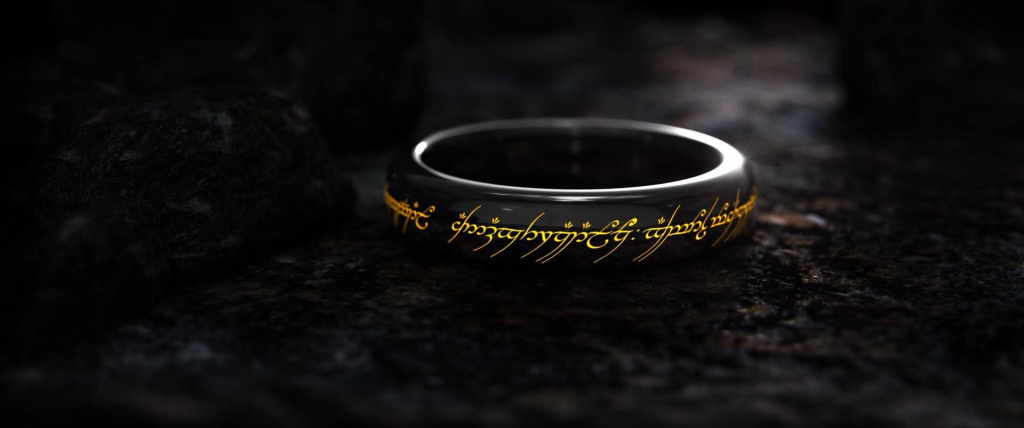
A funny thing happened. After watching Return of the King, a fire got lit within me that made me want to get into the Lord of the Rings again. No, I’m not talking about the 2003 Peter Jackson live action adaptation. I’m talking about the 1980 Rankin/Bass animated adaptation. If you’ve seen it before, I know what you must be thinking. That this adaptation is terrible, especially compared to the Peter Jackson film(s). Read me out.
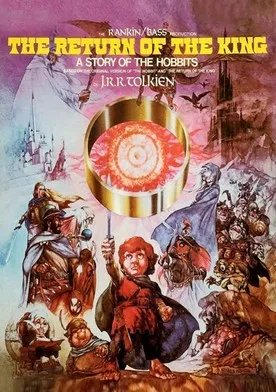
It’s true that the animated version cannot be considered a complete fully-rounded movie. It leaves out way too much stuff to satisfy any Tolkein fan worth his salt. As an example of what is left out, Gimli the dwarf, Legolas the elf, and Faramir the Dunadan (or man) are nowhere to be seen. On top of that, Aragorn’s character is nowhere near developed enough for his return to Gondor to have the impact and significance felt that is needed. Lastly, the film states that the battle of Gondor lasted for several days, as did Frodo’s time inside Mount Doom (not going to Mount Doom, but being inside of it), when in both the live-action film and the book it only lasted for a day (or two) and a few minutes respectively.
That all said, there are sequences in this film that it absolutely fucking nails. When it comes to depicting the internal struggles of the ring-bearer (Frodo, and to a lesser extent Sam), this film does it better than all three Peter Jackson films combined. Hell, it does it better during the first half of the runtime than the entire Jackson trilogy. It captures the mental anguish quite well. Plus there’s this great moment where Frodo holds the ring, and you see his appearance change from one who is haggard and weak from the journey and from carrying the ring, to one who seems like a powerful lord capable of intimidating anyone, to the point where he even makes Gollum hold back in fear. It’s one of the best moments ever put to film from the book, and it makes this movie. If nothing else, it also shows that the ring does have a power other than making people into assholes and turning them invisible.
The song and music that is utilized in that moment enhances the emotional impact to perfection. And regarding the singing/poetry done in the animated movie, I’ll admit it ranges from great to bad to overdone. It borders on annoying for the first 20-30 minutes of this movie. But it makes up for it during the second half. While I will acknowledge that the lyrics are on the shallow side, I found it overall necessary. Same deal with the narration. There are times in the medium of film where the visuals aren’t enough, where some narration (which songs be in of themselves) is needed. In fact, I’d go so far as to say they are an absolute necessity when it comes to making an adaptation of certain stories. Because they can make you more immersed in a fantasy world, make you feel more like you’re witnessing an actual fantasy epic, as opposed to something that is making you witness something epic but is lacking that extra “oomph” to make it fantasy. This film adds that extra “oomph,” albeit with mixed results.
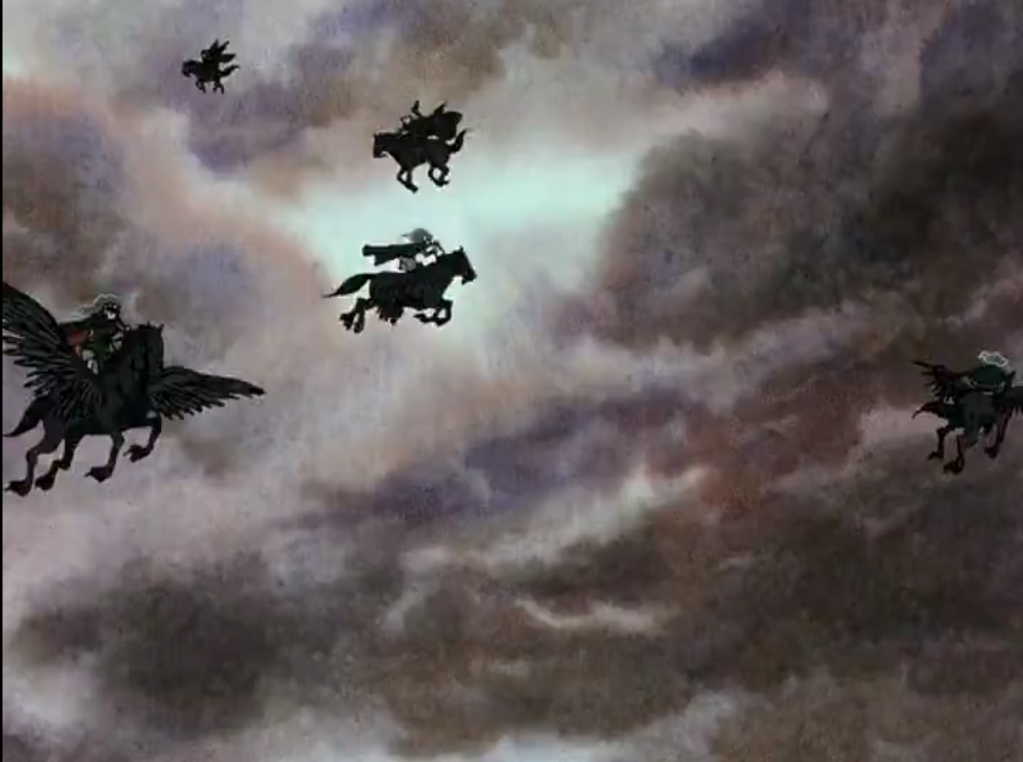
Really wish they didn’t use flying horses though.
An example of mixed results is when Aragorn and his army march to the Black Gate. Some of the lyrics are great with emphasizing the hopelessness of the situation. That no matter what they do, whether they stay to reinforce Minas Tirith, or go to attack Sauron’s forces, they will lose. This is emphasized briefly with the lyrics, “Win the battle lose the war.” The problem I had with this was that it had poor tempo. But it did have nice imagery with the remaining Nazgul flying threateningly above them.
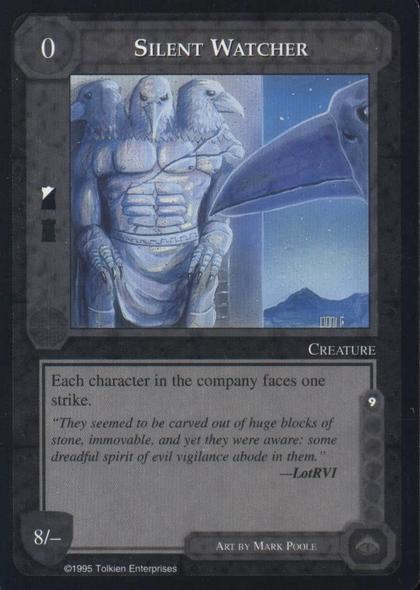
It was also nice of the film to include the Silent Watchers. Just including that extra bit made for good fantasy immersion. Some being/statue that isn’t fully explained, with a power that can’t be fully comprehended, that is overcome with another power that isn’t fully comprehended (the phial of Galadriel). It’s the sort of thing I want in more fantasy films. Have stuff included that doesn’t get an explanation as to why or how, it just is. It makes for good pondering, letting the viewer know there is more to discover that the film hints at, but goes beyond the scope of the story being told. The only other fantasy film I’ve seen do this in good fashion is The Dark Crystal.
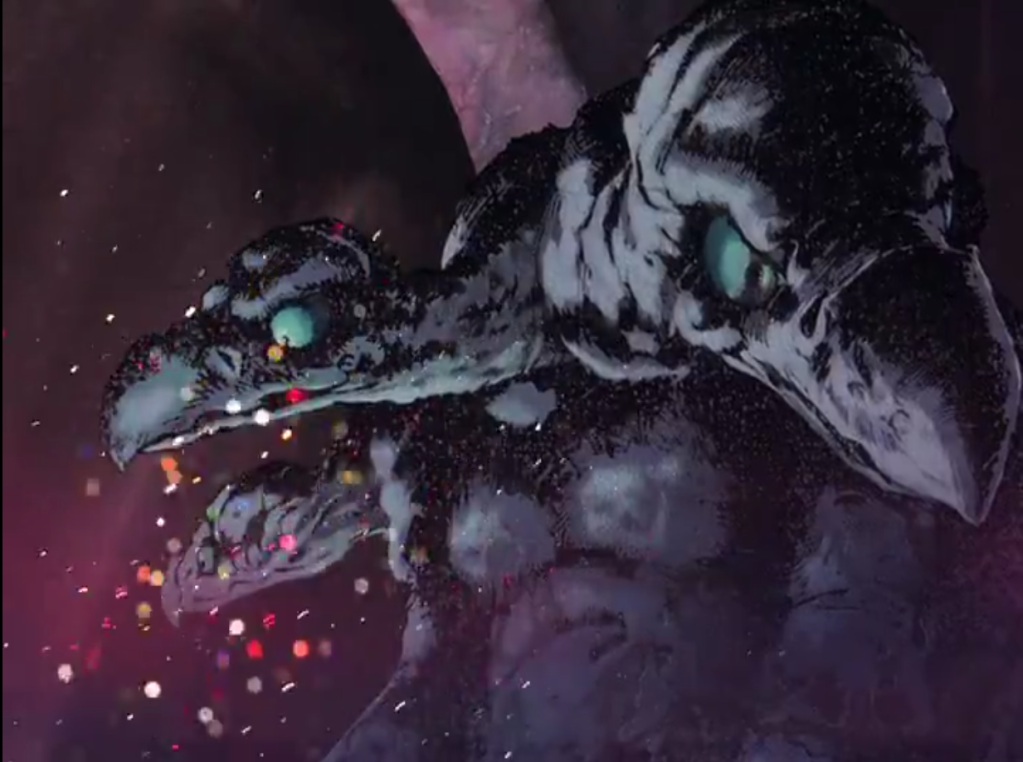
The Peter Jackson films aren’t entirely absent of stuff like this. I mean, they did include The Gates of Argonath, aka The Pillars of Kings (depicting Isildur and Anárion, with a hand held out indicating travelers should stop, lest they enter the realm of a once grand kingdom). The problem with their inclusion is that they really fucked up Aragorn’s character as a result. There is a significance to this in the novel. In the novel, when the fellowship passes by these statues, Aragorn’s demeanor changes, becoming more kingly, having a long suppressed emotion and royal lineage suddenly awaken, because his fate and purpose can no longer be ignored, by either himself or the people in the world. Instead of even hinting at that kind of awakening in his character, the films treat it as nothing other than relics from a past civilization that hold no emotional weight over the future and legitimate king of the land, and just keep him as fucking wallflower (at least as far as his kingly lineage is concerned). In fact, the movie version hates his own lineage.
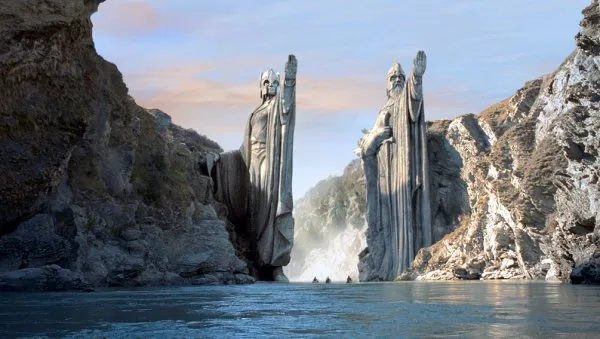
This goes with a theme that kind of rubs me the wrong way. The live-action film trilogy makes a strong point of denigrating the race of men. Starting as early as Elrond reminiscing on, “the day the will of men failed,” regarding Isildur not tossing the ring of power into the fires of Mount Doom. First of all, the way the films depict this past event is stupid. It’s an instance of Jackson having a scene happen in such a way to maximize dramatic effect, at the expense of logic, and at the risk of making it cringe (this is not the first, and nowhere near the last, time Jackson would do that in this film trilogy). The books, at least as far as I have read (having read the Lord of the Ring trilogy, but not the Appendix stuff, or the Silmarillion) don’t specify how this happened. For all I know, Isildur didn’t even go inside Mount Doom. There may have even been an implication that everyone desired the ring for one reason or another after the battle, including the fucking elves, even though the wisest among them were too fearful to take it (and rightly so). For all we know, no one in that battle at that time may have been capable (ie willful) enough to cast the ring into the fires. I mean, if Gandalf was too scared to take the ring, and if Galadriel had a harder time resisting it than him… Elrond had no right to judge Isildur, not even in the context of the Jackson films. In fact, it’s not even certain if everyone on that battlefield ever wanted the ring destroyed. A respectable number, even excluding men, may have wanted to use the ring themselves.
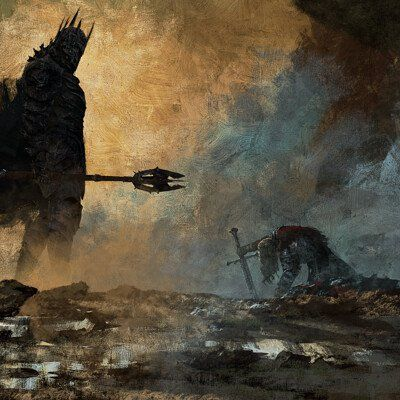
Second of all, the race of men were capable of beating back the orcs at Helms Deep by themselves without the help of Elves (as shown in the book). While I’ll admit it’s a cool moment in the movie to see the Elves help out in that battle, it clashes with the theme in the book that the race of men were going to have to stand on their own in the 4th age of Middle Earth when the race of elves (and possibly of Wizards) left the world. You know, to show that the race of men, in spite of how much it had fallen to shambles over the centuries, was capable of becoming reunited and standing as a strong force of good in the world to make up for the departure of the elves.
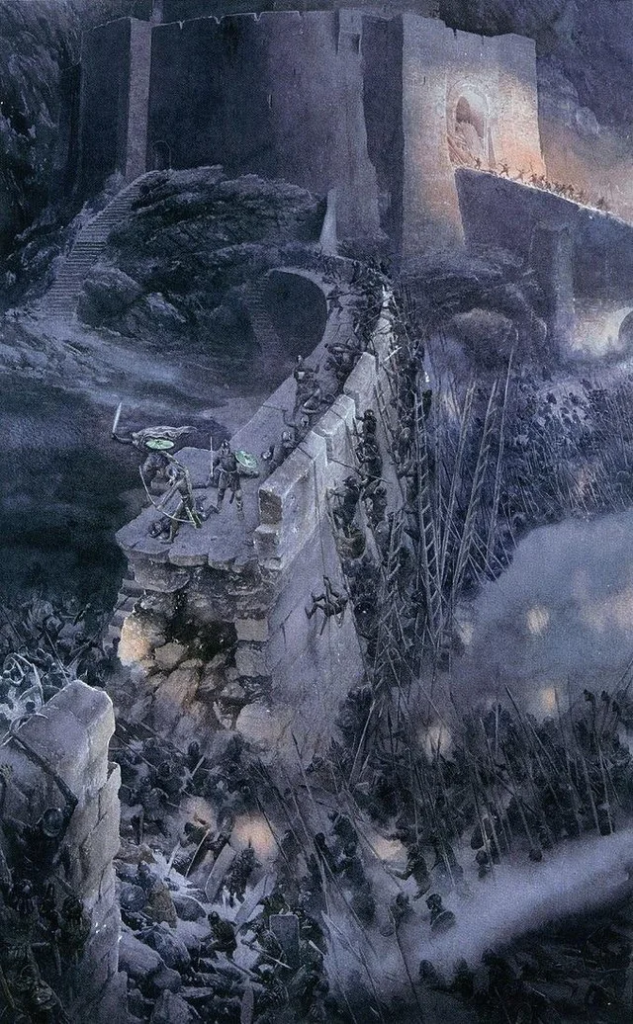
Third, Jackson wants to have his cake and eat it too (hence his weight) when it comes to Aragorn rejecting his bloodline and royal duties, and that whole Army of the Dead plot. Which also leads into the strange timing of when the elves re-forged Anduril. In the books, they did it in time for Aragorn to have it when the fellowship left Rivendell to being their journey to Mordor. In the movie, Aragorn gets it at a camp in Return of the King, for dramatic effect. It’s dumb when you think about it (travel time, enemies about the land, character motivations, etc).
*sigh*
But enough about all that. The other thing I liked more in the animated film than in the live-action flick is Eowyn’s battle with the Witch King. Putting aside how Theoden gets killed, for now, the main issue I have with it in the live-action adaptation is when Eowyn reveals herself to be a woman. It’s done at the last second before she kills the Witch King. You know, for dramatic effect. This comes at the expense of what revealing her sex before they clash entails. Revealing it early on makes for intense setup. Like you’re about to witness something prophetic happen. As opposed to coming off exclusively as a, “Girl Power For The Win!” moment. These Jackson “dramatic effect” moments wind up cheapening the experience, especially upon a rewatch.
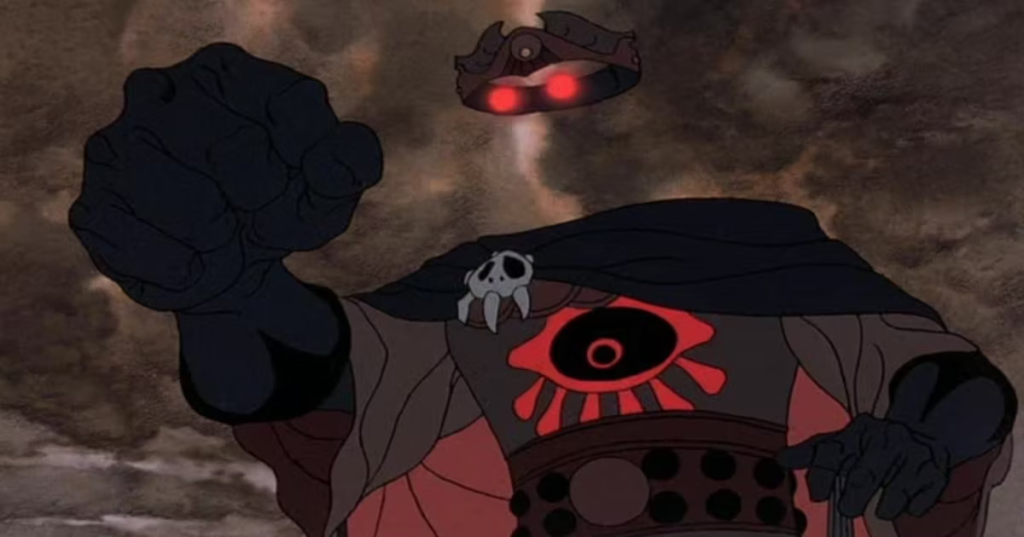
That said, while the animated version did the Eowyn/Nazgul clash more faithfully to the book compared to the live action flick, it wasn’t faithful enough. But this is another one of those instances where it was impossible for the animated film to do it justice given what it left out. There was nothing regarding her love for Aragorn that he would not reciprocate. Which was a driving factor for her going into battle with a death wish. And she did this for more than just a broken heart, it was also because she didn’t believe her purpose in life would be fulfilled: to be a queen (an aspect that could only be put forth in the films if the character of Aragorn was more like he was in the book, accepting his royal lineage rather than rejecting it). So in the animated film, all it could do was just show her as a brave determined woman who is capable of inspiring others to fight as bravely as herself (in the book this is an unintended consequence that happens for a different reason; making her brother and his forces fight with wrath and vengeance upon seeing her seemingly lifeless body on the field). Aside from that, in the battle, the arm that held her shattered shield got broken, and her other arm she used to slash the Witch King’s head became paralyzed, which emphasized how dangerous it is to clash with such a powerful agent of darkness. In fact, her paralyzed arm (and Merry’s too, as he also slashed at the Witch King) caused her body to be infected with shadow that would eventually kill her if something wasn’t done. The consequences of this battle aren’t depicted well in either film adaptation (though in all fairness, the extended edition of the live-action film does get closer regarding the aftermath and treating her injuries).

But there is one liberty the animated film took that actually worked compared to the book. It takes liberties with the timing regarding where in Mordor (and Mount Doom) Frodo and Sam are compared to when events with the siege of Minas Tirith and battle in Pelennor Fields takes place. It does this to depict not only a small personal struggle between one or two individuals with this war against darkness, but also contrasting it with a larger struggle involving kingdoms and armies. To do this, it shows how the tide goes back and forth on both the personal and grand scale fronts. For instance, Frodo and Sam struggle in Mordor, the armies in Minas Tirith are despairing amidst the siege. Then the riders of Rohan appear to restore hope in Minas Tirith, which causes the tide to turn there. Once that happens, Frodo makes a recovery from what the burden was doing to him, and is able to continue on the journey. But then Frodo becomes consumed by the power of the ring, which is when a darkness comes forth out of Mordor over the fields of Pelennor, which causes king Theoden to fall and the Witch King to make another appearance. It subtly indicates that the direction of the tide in a struggle affects that of the other, how small personal battles have a rippling effect that can alter events on a grand scheme in a grander conflict. That there is an aura in the world that is affected by both small and large struggles. That the high stakes battle against the armies of shadow on a battleground can affect the aura felt by those in another land, and how their ow small battle can likewise affect the aura on a large battlefield in the other land. Indicating there is a higher force at work also involved in the struggles, whose influence is also dependent on how well one weathers the obstacles they must face. This aspect of the film solidified it for me as an underappreciated, albeit still flawed, gem of a movie.

Hence to say, this animated film, for all its faults, showcased the potential of what could’ve been. It showed what a film adaptation of Lord of the Rings done right could’ve been. It may not be a solid well-rounded movie that all others should be measured up against, but it has moments demonstrating that it’s possible to make a Lord of the Rings film and getting it right. After seeing this “what could’ve been” potential, it left me further frustrated with Jackson’s adaptation. He isn’t capable of depicting this “aura,” this “environment,” of good and evil to influence those upon the world. Not even when he dared open up the trilogy with the lines, “The World is changed. I feel it in the water. I feel it in the earth. I smell it in the air.” I mean, what the fuck Jackson? You promising that aspect of it and not delivering? What the hell’s wrong with you? The only “feels” he attempted in this movie was the ring’s influence on making people want to possess it and wear it, which in all fairness was done at a reasonable effort (though I won’t say perfect). But what about the other “feels?” Legolas making a half-assed speech does not count!
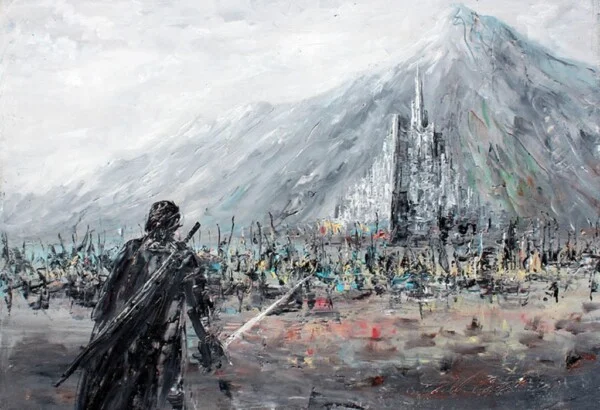
One final note of comparison between the films. I fucking hated Samwise Gamgee’s character in the live-action films. You know what he is? A Marty Stu. The male equivalent of a Mary Sue. Here’s a fucking character incapable of doing any wrong, who gets to strong and skilled way too fucking fast, and it comes at the expense of others. First evident in Moria when he’s smashing orcs with a fucking frying pan, and not receiving any injury during the entirety of The Fellowship of the Ring story (that wasn’t the case in the book). How he’s able to fight off Shelob; not so much that he’s able to do it so much as how he’s depicted as doing it in the film compared to the book. Killing off a half-dozen orcs, in one sitting, at the tower Frodo was held in. And who has no weaknesses whatsoever. The only thing carried over from the book is his anger issues (because in the book he is a character primarily driven by strong emotions more than anything else, which goes with joy, sadness, and anger). There was nothing regarding his temptation to keep the ring for himself and use it (an aspect that at least had a respectable amount of time in one sequence in the animated flick). There was no instance where he regretted letting his emotions get the best of him (in the book, it happened in his talk with Faramir, and when his wrath against Gollum made him forget about Frodo and Shelob for a near-fatal instant). Just something to make him fallible. If nothing else, at least the animated film took away his ability of being a one-man army.
The main problem I have with the Peter Jackson films is the precedent they set with most Hollywood films that came out afterwards. No, I’m not talking about making a series of films that can’t stand alone on their own as a single film without the benefit of sequels to complete them (I blame that on Harry Potter). It’s that is has a lot of tropes that weren’t so common back then, but are all too common now, and I hate them. Someone is in danger, but are saved at the last second. Everyone is fine and safe, but then something bad happens at the last possible moment it could happen. Seems like someone just died, but they’re fine a few seconds later. Something bad is about to happen until someone/something prevents it at the last second. It’s always “at the last second.” I really fucking hate those moments that play up dramatic tension until the last second. I blame the Jackson trilogy of films for popularizing this fucking trend. It may not have been the first to do this (anime has its own reputation in that department, and I fucking hate it in that too, and in manga), but it sure as hell made it a trend.
Oh, right, and the live-action films made the Ents retarded. Seriously, their mental capacity got a serious downgrade compared to the books, primarily just to benefit Merry and Pippin influencing them to attack Isengard.
There’s more I could bitch about, but I’m going to leave it at that regarding those films. The animated film managed to ignite an interest in the franchise that I didn’t think I had in me. Aside from getting me to read (and finish) the book trilogy (something I failed to do many years ago), it also reignited my interest in some Lord of the Rings board games that I either never gave a fair shake, or never got to shake.
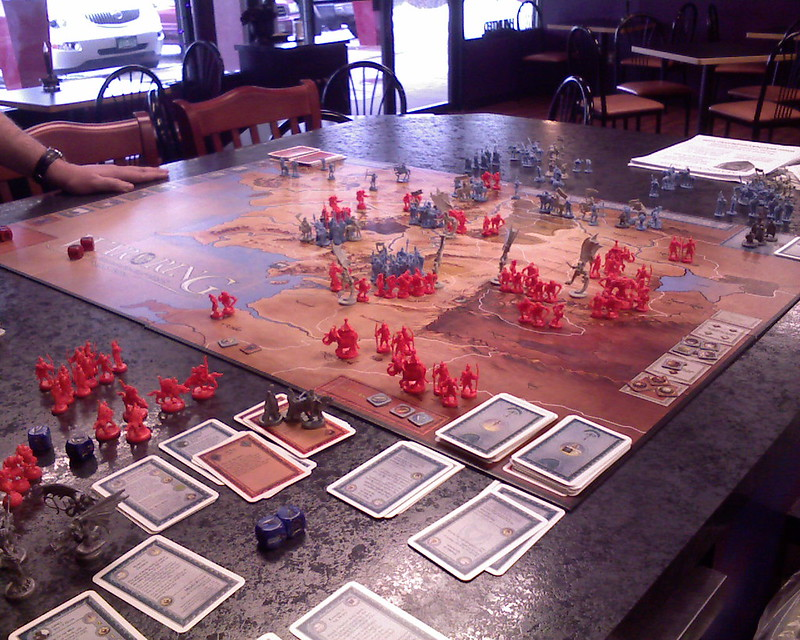
Which caused me to purchase and play one of the greatest modern (ie made within the last 20 years) board games ever made, War of the Ring (2nd edition, 2011). This is something I spent more money on than I would care to admit. Let’s just say, while this dudes-on-a-map game is pretty good, you have to do some personal work on it to make it that good. It’s not just bad guys versus good guys (red vs blue), it’s different factions of bad guys who look similar from a distance versus even more different factions of good guys who also look similar from a distance. In other words, you’ll need to paint the bases different colors so that they can be distinguished from one another. On top of that, the map leaves something to be desired: mountains. So that it is easy to tell which regions are blocked off, so that you don’t accidentally and illegally move an army through them. Though in all fairness, there are two solutions to this: either get some 3D mountains, or get a custom game mat that makes the mountains more obvious (this exists, and it actually a pretty damn good map).
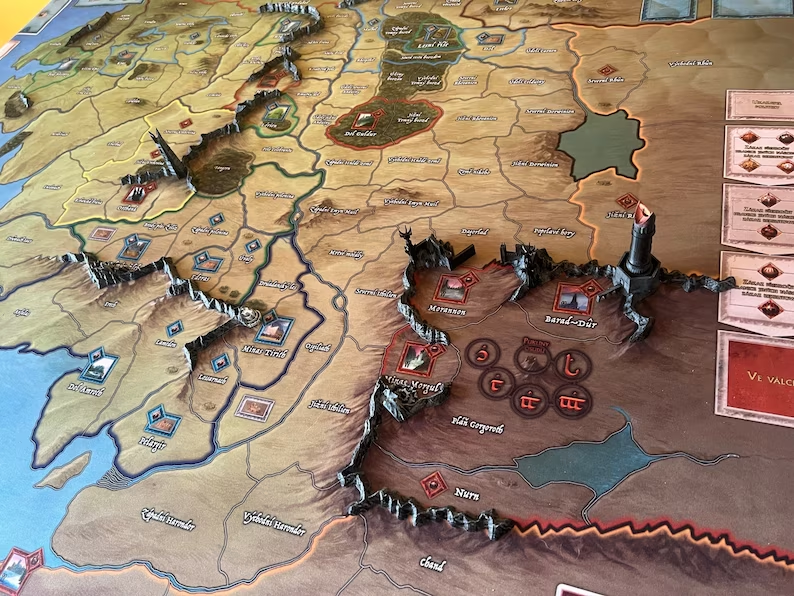
This is not included with the game. This is not an official expansion. I had to go on Etsy.com to get this.
And that’s not even getting to the expansions. Or this fan-made rework that combines all the expansions, and the other game Battle of the Five Armies, into one, with a different set of rules and components that make it feel like a different game in spite of having the same board, models, and win conditions. Anyway, if you want a shorter version of this game that is more simplified, more combat based, and has less thematic “what-if” scenarios that could happen, I can recommend Battle of the Five Armies.
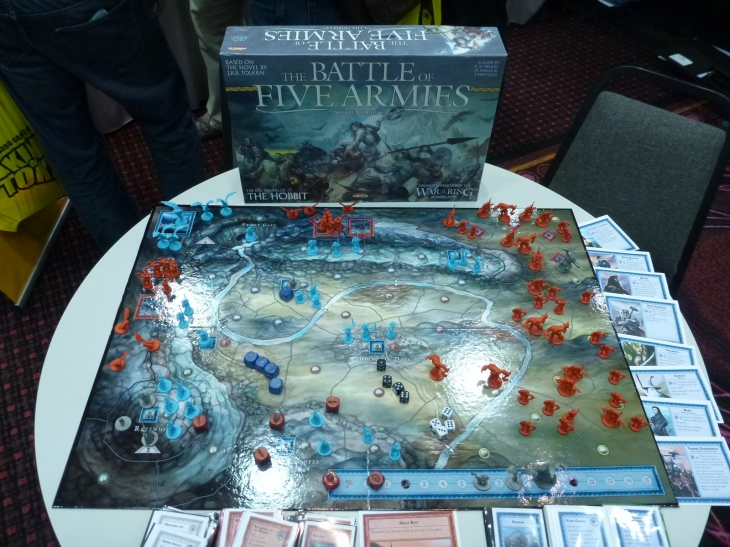
Then, of course, there’s that 1990’s collectible card game that’s been long out of print, Middle Earth. Very unique compared to every other CCG I’ve ever played. It’s a good game, but I forgot how much of a money sink CCGs can be, even if they’re out of print. If you were to get started with this CCG, take my advice and only focus on the cards from The Wizards set (ie the first set ever made). Don’t get cards from any of the other sets that came afterwards until you are damn sure you’re happy with what The Wizards set offers. It’s not difficult to get started, it’s difficult to get the cards needed to build the deck you optimally would want (more out of personal preference than out of necessity for winning). Others have put it best when they say this is an RPG disguised as a CCG. Because there’s actual travelling around the map involved (strongly recommended you toss the region cards and just use a map instead; there are version out there free to print out). And you remember when I stated how I admired the animated film for indicating the environment has an aura about it that can affect the morale of the good guys and/or the bad guys? This game has cards that depict that aura, on a variety of levels. This game has a lot of the small details that are in the books put into CCG form that makes them significant. And you can tell this is without the influence of the live action films; it came out (and went out of print) before those came into existence; an aspect that all other Lord of the Rings games that have any merit unfortunately do not possess.
The other Lord of the Rings games I’ve played that I can recommend include Lord of the Rings: The Confrontation (try to get the Deluxe edition if you can, though it’s been long out of print), Middle Earth Quest (also long out of print, but still affordable; I also recommend utilizing The Longer Game Variant by Mr. Skeletor of ThereWillBeGames; it does away with this anti-climactic final battle that nobody likes, and is the only real weak point of the game).
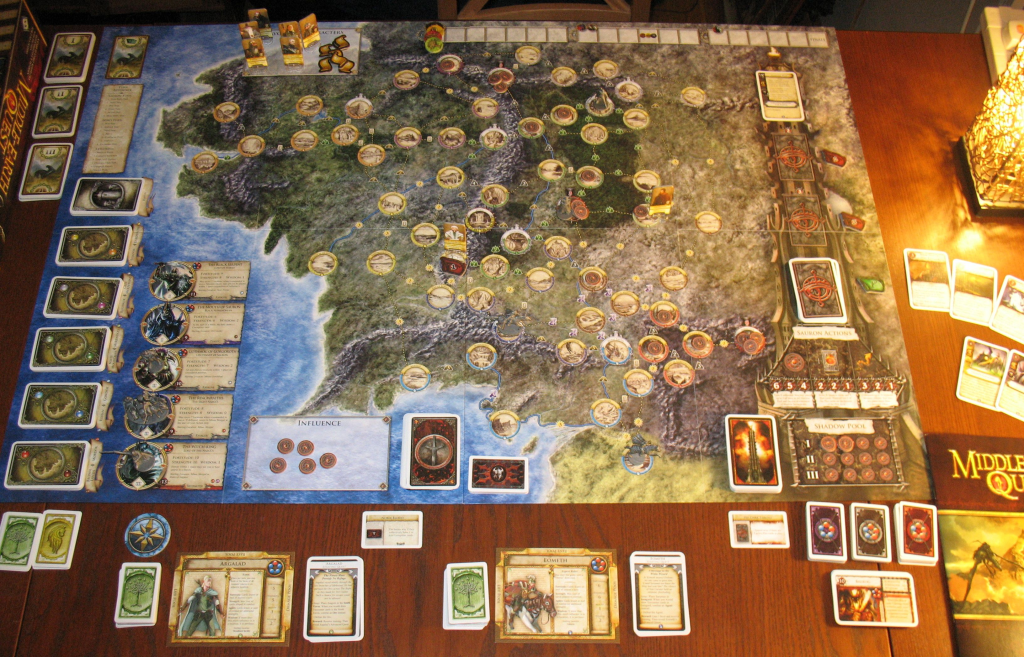
There are other Lord of the Rings board games out there, some of which I’m sure have almost as much merit as the ones I mentioned here, but these should do enough to satisfy. That said, I have yet to try The Hunt for the Ring, or Journeys in Middle Earth.
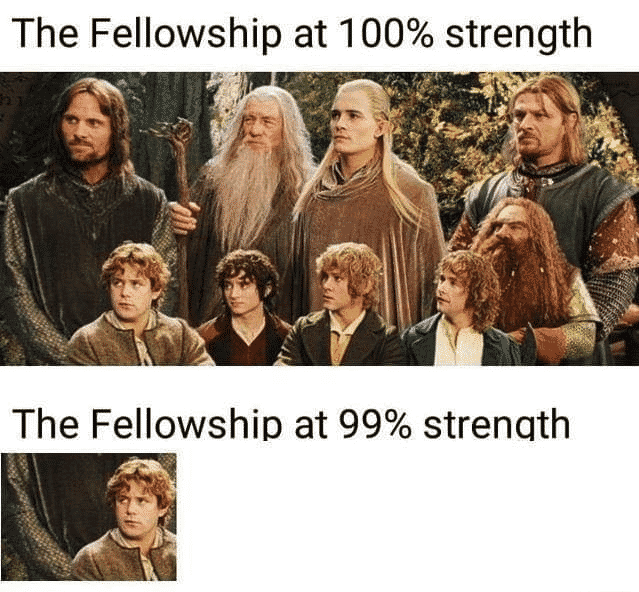
PS: Now I have to edit my top 50 films of all time list at some point. I knew I had a reason for dreading to rewatch the Lord of the Rings trilogy again. They are good movies, don’t get me wrong. They’re just not the masterpieces I remember them being all those years ago.
